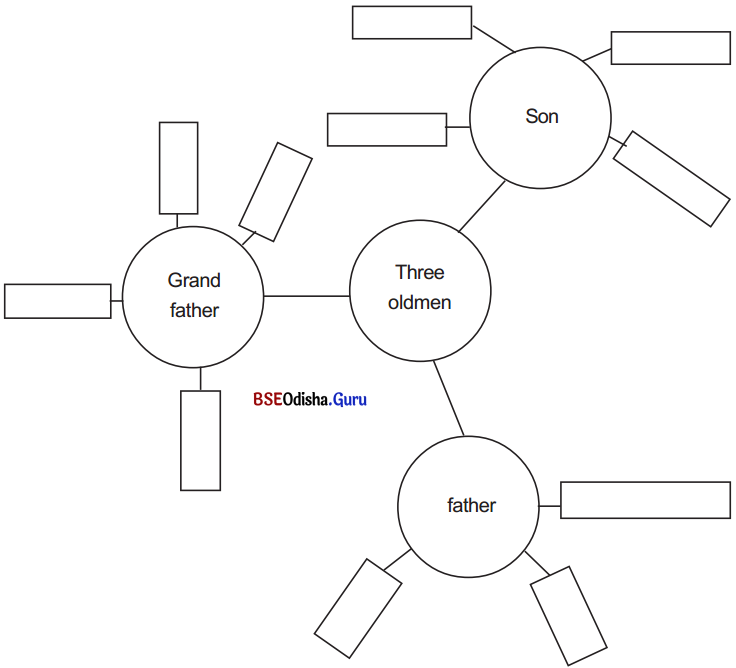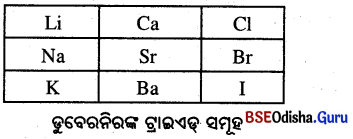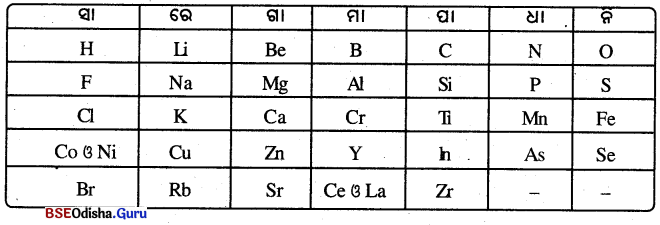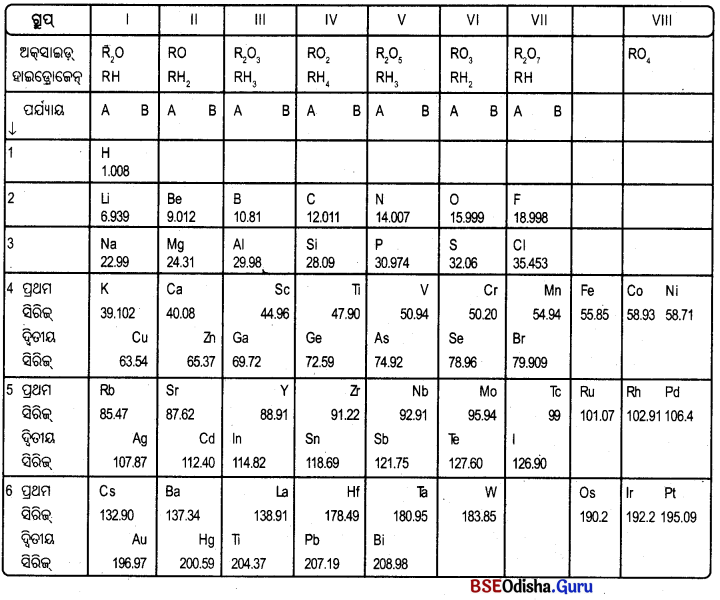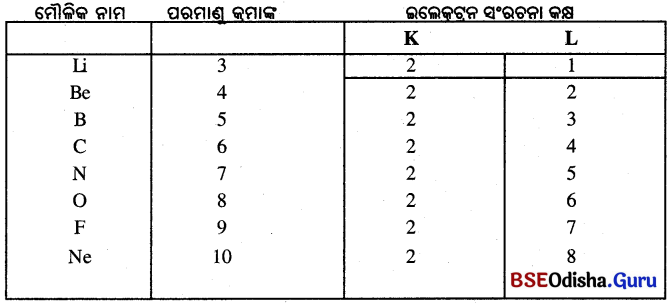Odisha State Board BSE Odisha 10th Class English Solutions Non-Detailed Chapter 5 A Great Son of India Textbook Exercise Questions and Answers.
Class 10th English Non-Detailed Chapter 5 A Great Son of India Question Answers BSE Odisha
A Great Son of India Class 10 Questions and Answers
LEAD – IN
Many great saints (sages: ମୁନିଋଷି) were born in India. One among these carried the teachings (ଧର୍ମବାଣୀ) of the Upanisads to the people of the world. The great and liberal philosophy of India fascinated (attracted) the audience when the young saint spoke to them in simple words but with profound (deep) faith and confidence. Here Dr Sarvapalli Radhakrishnan, the great teacher and philosopher (ଦାର୍ଶନିକ) speaks about him on the saint’s 92nd birthday. Let’s read the lesson to know more about the great son of India.
SUMMARY
The writer/philosopher Dr Sarvapalli Radhakrishnan feels pleasure to be at the August (auspicious) gathering for distributing prizes for recitation and speech competitions.
- He has cited (exemplified) the glorious life and teachings of Vivekananda, one of the great leaders of the Indian Renaissance.
- Vivekananda like his contemporaries (ସମସାମୟିକ) didn’t preach a new system of thoughts.
- He only interpreted and conveyed ( ଜଣାଇଥିଲେ )to the world India’s religious consciousness, treasures of the past.
- Radhakrishnan in his speech, advocates (stress; ଗୁରୁତ୍ୱ ପ୍ରଦାନ କରିଛନ୍ତି) the life and teachings of Swami Vivekananda, inspired by his religious Guru Shri Ramakrishna.
- The two dominant (influential) features science and democracy have continued to stay in India.
- But it is impossible to educate the Indians to accept religious faith without rational evidence.
- Religion in the views of Radhakrishnan should sustain our faith in democracy
- Any religion that tends to divide man from man, supports privileges (opportunism; ସୁବିଧାବାଦ) exploitation, wars etc. shouldn’t be practised by us.
- The naked (open) truth in our life is the transience (କ୍ଷଣସ୍ଥାୟିତ୍ଵ) of all sorts of things including our glorious deeds, heroism, etc.
- The Upanisads give us an explanation of the fundamental problem of another world beyond ours.
- According to Vivekananda, the Vedas are not simply books but they are the accumulated ‘ treasure of spiritual laws discovered by different persons in different times.
- For him, religion is yoga, personal change, adjustment and integration.
- It is neither (not) profession of a doctrine nor intellectual orthodoxy.
- Religion is all about awakening the life of the spirit in man.
- Our intolerance germinates (is created) from our prejudicial ideas (ସଂକୀର୍ତ୍ତି ଧାରଣା ) of the systems of faith.
- But we should remember that intolerance is an expression of religious conceit, not humility.
- According to Radhakrishnan, in the name of secularism, we shouldn’t promote intolerance.
- Rather we should understand and love other religions.
- Quoting Ramakrishna, Vivekananda said, “We Hindus don’t tolerate but identify ourselves with the worship or prayers of the Mohammedans, Zoroastrians or the Christians.”
- Vivekananda protested strongly against the abuse of religion and insistence on untouchability or touch ability.
- In order to profit from the teachings of Vivekananda, we should try to build a spiritual region above the narrowed ecclesiastical views.
![]()
PART – I
I am happy to be here and distribute prizes for recitation and speech competitions. I congratulate those who have won these rewards on their achievements. The students who won the prizes and the many others who competed for them had the great opportunity of reading some of the writings of Swami Vivekananda. I have no doubt they have been impressed and inspired by what they have read. Vivekananda’s life and teachings have prepared us for the new age of freedom in which we live.
They tell us how best we can consolidate the freedom we have recently won. He was one of the great leaders of the Indian Renaissance. Like all the great teachers of India, Vivekananda did not profess to be the formulator of a new system of thought. He interpreted for us and the world India’s religious consciousness, the treasures of her past. His writings and speeches are all fortified by quotations from the Indian scriptures and the life and sayings of his great Master, that transcendent religious genius, Shri Ramakrishna.
In the short time at my disposal, it will not be possible for me to speak on more than one or two aspects of Vivekananda’s teaching. The two dominant features of our age are science and democracy. They have come to stay. We cannot ask educated people to accept the deliverances of faith without rational evidence. Whatever we are called upon to accept must be justified and supported by reason. Otherwise, our religious beliefs will be reduced to wishful thinking.
Modem man must learn ‘ to live with a religion which commends itself to his intellectual conscience, to the spirit of science. Besides, religion should be sustaining faith in democracy or race. Any religion which divides man from man or supports privileges, exploitation, and wars, cannot commend itself to us today. If we are passing through a period of the eclipse of religion, of the light of heaven, it is because religions, as they are practised, seem to be both unscientific and undemocratic. The most obvious fact of life is its transcience.
Everything in this world passes away, the written word, the painted picture, the carved stone, the heroic act. Great civilizations are subject to the law of time. The earth on which we live may one day become unfit for human habitation as the sun ages and alters. Our acts and thoughts, our deeds of heroism, and our political structures are a part of history, of becoming, or process. They all belong to the world of time. Time is symbolized in India’s tradition by birth and death.
Is this world which is a perpetual procession of events, self-sustaining, self-maintaining, self-established, or is there a Beyond underlying it, unifying it and inspiring it, standing behind it and yet immanent in it? Is it becoming all or is there being behind it? Will man annihilate nothingness or will nothingness annihilate him? This very problem, this dread, this anxiety that we have, this feeling of the precariousness of the world bears witness to the world beyond. It is a longing for life eternal in the midst of time. Because of the implicit awareness of the ultimate reality, we have a sense of godforsakenness.
ଅନୁବାଦ : ବକ୍ତୃତା ପ୍ରତିଯୋଗିତା ଓ ଗାୟନ ନିମିତ୍ତ ପୁରସ୍କାର ବଣ୍ଟନ ଓ ଏଠାରେ ନିଜର ଉପସ୍ଥିତିକୁ ନେଇ ମୁଁ ଆନନ୍ଦିତ । ମୁଁ ସେହିମାନଙ୍କୁ ଅଭିନନ୍ଦନ ଜଣାଉଛି ଯେଉଁମାନେ ସେମାନଙ୍କର କୃତିତ୍ଵ ପାଇଁ ପୁରସ୍କାର ଲାଭ କରିଛନ୍ତି । ଯେଉଁ ଛାତ୍ରଛାତ୍ରୀ ପୁରସ୍କାର ଜିତିଥିଲେ ଓ ଅନ୍ୟ ଯେଉଁମାନେ ସେଗୁଡ଼ିକ ପାଇଁ ପ୍ରତିଯୋଗିତା କରିଥିଲେ, ସେମାନଙ୍କ ପାଖରେ ସ୍ଵାମୀ ବିବେକାନନ୍ଦଙ୍କର କେତେକ ଲେଖା ପଢ଼ିବାର ମହାନ୍ ସୁଯୋଗ ଥିଲା । ସେମାନେ ଯାହା ପଢ଼ିଛନ୍ତି ତାହାଦ୍ୱାରା ସେମାନେ ଯେପରି ମୁଗ୍ଧ ଓ ଅନୁପ୍ରାଣିତ ହୋଇଛନ୍ତି ସେଥିରେ ମୋର ସନ୍ଦେହ ନାହିଁ । ଆମ୍ଭେମାନେ ବାସ କରୁଥିବା ସ୍ଵାଧୀନତାର ନୂତନ ଯୁଗ ପାଇଁ ବିବେକାନନ୍ଦଙ୍କର ଜୀବନୀ ଓ ଧର୍ମବାଣୀ ଆମ୍ଭମାନଙ୍କୁ ପ୍ରସ୍ତୁତ କରିଛି ।
ନିକଟ ଅତୀତରେ ଆମ୍ଭେମାନେ ପ୍ରାପ୍ତ କରିଥିବା ସ୍ବାଧୀନତାକୁ କିପରି ଆମ୍ଭେ ଦୃଢ଼ ଭାବରେ ବଜାୟ ରଖୁରିବା, ସେସବୁ (ବିବେକାନନ୍ଦଙ୍କର ଧର୍ମବାଣୀ) ଆମ୍ଭମାନଙ୍କୁ ଦର୍ଶାଉଛି । ଭାରତୀୟ ନବଜାଗରଣର ସେ ଅନ୍ୟତମ ମହାନ୍ ନେତା ଥିଲେ । ଭାରତର ଅନ୍ୟ ସମସ୍ତ ମହାନ୍ ନେତାଙ୍କ ଭଳି ବିବେକାନନ୍ଦ ଏକ ନୂତନ ଚିନ୍ତାଧାରାର ପ୍ରବର୍ତ୍ତକ ରୂପେ ପ୍ରଚାର କରି ନ ଥିଲେ । ସେ ଆମ୍ଭମାନଙ୍କ ପାଇଁ ଓ ପୃଥିବୀ ପାଇଁ ଭାରତର ଧାର୍ମିକ ସଚେତନତା, ତାହାର (ଭାରତର) ଅତୀତର ଗର୍ବ ଓ ଗୌରବ ଆଦିକୁ ବ୍ୟାଖ୍ୟା କରିଥିଲେ । ଭାରତୀୟ ଧର୍ମପୁସ୍ତକ ଓ ତାଙ୍କର ମହାନ୍ ଧର୍ମଗୁରୁ ଶ୍ରୀରାମକୃଷ୍ଣ ପରମହଂସଙ୍କର ଜୀବନୀ ଓ ଧର୍ମ ଉପଦେଶଗୁଡ଼ିକରୁ ଆନୀତ ଉକ୍ତିସବୁଦ୍ୱାରା ବିବେକାନନ୍ଦଙ୍କର ଲେଖା ଓ ଭାଷଣ ସବୁ ଦୃଢ଼ୀଭୂତ ହୋଇଛି । ମୋ ପାଖରେ ଥିବା ସୀମିତ ସମୟ ମଧ୍ୟରେ ବିବେକାନନ୍ଦଙ୍କର ଅମୂଲ୍ୟ ବାଣୀର ଗୋଟିଏ ବା ଦୁଇଟି ଦିଗ ଅପେକ୍ଷା ଅଧିକ ଉପରେ ଉଲ୍ଲେଖ କରିବା ମୋ ପାଇଁ ସମ୍ଭବ ହେବ ନାହିଁ ।
ଆମ ଯୁଗର ଦୁଇଟି ପ୍ରଭାବଶାଳୀ ବୈଶିଷ୍ଟ୍ୟ ହେଉଛି ବିଜ୍ଞାନ ଓ ଗଣତନ୍ତ୍ର । ଏହି ଦୁଇଟି ଆମ ସମାଜରେ ବାସ କରିସାରିଲେଣି । ବିନା ବିଚାରଶକ୍ତି ପ୍ରମାଣରେ ଆମ୍ଭେମାନେ ଧର୍ମ ପ୍ରଚାର ବା ଧର୍ମ ଉଦ୍ବୋଧନକୁ ଗ୍ରହଣ କରିବାପାଇଁ ଶିକ୍ଷିତମାନଙ୍କୁ ଉପଦେଶ ଦେଇପାରିବା ନାହିଁ । ଆମ୍ଭମାନଙ୍କୁ ଯାହା ଗ୍ରହଣ କରିବାକୁ କୁହାଯାଏ, ତାହା କାରଣ ବା ବିଚାରଶୀଳତାଦ୍ୱାରା ସମର୍ଥିତ ଓ ଯୁକ୍ତିଯୁକ୍ତ ହୋଇଥିବା ଆବଶ୍ୟକ । ନଚେତ୍ ଆମ୍ଭମାନଙ୍କର ଧାର୍ମିକ ବିଶ୍ୱାସ କେବଳ ଖୁଲୀ ଚିନ୍ତାକୁ ହ୍ରାସ ପାଇବ । ଆଧୁନିକ ବ୍ୟକ୍ତି କିପରି ଗୋଟିଏ ଧର୍ମ ଭିତରେ ବାସ କରିବାକୁ ହେବ ତାହା ଶିଖୁବା ଉଚିତ; ଯେଉଁ ଧର୍ମ ତାହାର ବୌଦ୍ଧିକ ଚେତନା ଓ ବିଜ୍ଞାନ ସମ୍ପର୍କିତ ଭାବନା ମଧ୍ୟରେ ନିଜକୁ ପ୍ରଶଂସିତ କରାଏ । ଏତଦ୍ବ୍ୟତୀତ, ଧର୍ମ ଗଣତନ୍ତ୍ର ବା ଜାତିର ଚିରନ୍ତନ ଜୀବନରକ୍ଷକ ଭାବନା ହେବା ଉଚିତ । ଯେକୌଣସି ଧର୍ମ ଯାହା ମଣିଷ ମଣିଷ ମଧ୍ୟରେ ବିଭାଜନ ଆଣେ ବା ସୁବିଧାବାଦ, ଶୋଷଣ, ଯୁଦ୍ଧକୁ ପ୍ରୋତ୍ସାହିତ କରେ ଆଜି ନିଜକୁ ପ୍ରଶଂସିତ କରିପାରିବ ନାହିଁ ।
ଯଦି ଆମ୍ଭେମାନେ ଧର୍ମ କ୍ଷୟ ବା ସ୍ଵର୍ଗୀୟ ଆଲୋକର ଅବଧୂ ନିସ୍ପୃହତା ଦେଇ ଗତି କରୁଛି, ଏହାର କାରଣ ଧର୍ମଗୁଡ଼ିକୁ ଯେଭଳି ଗ୍ରହଣ କରାଯାଉଛି ତାହା ଅଣବିଜ୍ଞାନ ଓ ଅଗଣତାନ୍ତ୍ରିକ ମନେହେଉଛି ।
ଜୀବନର ସବୁଠାରୁ ଗ୍ରହଣଯୋଗ୍ୟ ସତ କଥା ହେଉଛି ଏହାର ଅସ୍ଥାୟିତ୍ଵ । ଏହି ପୃଥିବୀରେ ସବୁକିଛି ଯଥା ଲିଖ୍ ଶବ୍ଦ, ଅଙ୍କିତ ଚିତ୍ର, ଖୋଦିତ ପଥର, ବୀରତ୍ଵ କାର୍ଯ୍ୟ ଅପସରି ଯାଉଛି । ବୃହତ୍ ସଭ୍ୟତା ସବୁ ସମୟର ନିୟମାଧୀନ । ଆମ୍ଭେ ଯେଉଁ ପୃଥିବୀ ଉପରେ ବାସ କରୁଛୁ ତାହା ସୂର୍ଯ୍ୟ ବୟସ୍କ ହେବା ଓ ପରିବର୍ତ୍ତିତ ହେବା କାରଣରୁ ମାନବୀୟ ବସବାସ ପାଇଁ ଅନୁପଯୁକ୍ତ ହୋଇପଡ଼ିବ । ଆମ୍ଭମାନଙ୍କର କାର୍ଯ୍ୟ ଓ ଚିନ୍ତାଧାରା, ଆମ୍ଭମାନଙ୍କର ବୀରତ୍ଵ କାର୍ଯ୍ୟାବଳୀ, ଆମ୍ଭମାନଙ୍କର ରାଜନୈତିକ ଢାଞ୍ଚା ଇତିହାସର ଏକ ଅଂଶ ଅଟେ; ଭବିଷ୍ୟତରେ ହେବାର ବା ପ୍ରକ୍ରିୟାର । ସେସବୁ ସମୟ ସମ୍ବନ୍ଧୀୟ ପୃଥିବୀର ଅନ୍ତର୍ଭୁକ୍ତ ।
ଭାରତୀୟ ପରମ୍ପରାରେ ଜନ୍ମ ଓ ମୃତ୍ୟୁକୁ ସମୟଦ୍ବାରା ପ୍ରତୀକାତ୍ମକ ଭାବରେ ଗ୍ରହଣ କରାଯାଇଥାଏ । ଇଏ କ’ଣ ସେଇ ପୃଥିବୀ ଯାହା ହେଉଛି ସୁରକ୍ଷାକାରୀ, ସୁରକ୍ଷଣାବେକ୍ଷଣକାରୀ, ସୁପ୍ରତିଷ୍ଠିତ ଘଟଣାବଳୀର ଏକ ଚିରନ୍ତନ ପ୍ରକ୍ରିୟା କିମ୍ବା ଏହାର ଊର୍ଦ୍ଧ୍ବରେ ଏହାକୁ ଗୁରୁତ୍ୱ ଦେଉଥି, ଏହାକୁ ଏକତ୍ର କରୁଥିବା ଓ ଏହାକୁ ପ୍ରେରଣା ପ୍ରଦାନ କରୁଥିବା, ଏହା ପଛରେ ଠିଆ ହୋଇଥିବା ଏବଂ ତଥାପି ଏହା ଭିତରେ ସର୍ବବ୍ୟାପକତା ଅଛି ? ପୃଥିବୀ କ’ଣ ଆମ୍ଭମାନଙ୍କ ପାଇଁ ସବୁକିଛି ହୋଇଯାଉଛି ବା ଏହା ପଛରେ କିଛି ଅଛି ? ମଣିଷ କ’ଣ କିଛି ନ ଥିବାର ସ୍ଥିତିକୁ ସମୂଳେ ଧ୍ଵଂସ କରିବ ବା କିଛି ନ ଥୁବାର ସ୍ଥିତି ମଣିଷକୁ ସମୂଳେ ଧ୍ଵଂସ କରିବ ? ଏହି ସମସ୍ୟା, ଏହି ଭୟ, ଏହି ବ୍ୟାକୁଳତା ଯାହାସବୁ ଆମ୍ଭମାନଙ୍କଠାରେ ରହିଛି, ପୃଥିବୀର ବିପନ୍ନ ଅବସ୍ଥାର ଏହି ଅନୁଭୂତି ପାରତ୍ରିକ ଜଗତ ପାଇଁ ସାକ୍ଷୀ ବହନ କରିଥାଏ । ସମୟର ଅନ୍ତରାଳରେ ଏହାହିଁ ଜୀବନକୁ ଚିରନ୍ତନ କରିବାର ଅଭୀପ୍ସା ।
![]()
Word Meaning / Glossary:
recitation – act of recitation (ଆବୃତ୍ତି)
consolidate – strengthen (ମଢ଼ୀଭୂତ କରିବା)
Renaissance – Reawakening ( ନଜାଗରଣ
interpreted – illustrated (ବ୍ୟାଖ୍ୟା କଲେ)
treasures – heritage (ଐତିହ୍ୟ)
are fortified – are strengthened (ଶକ୍ତିଶାଳୀ )
transcendent – superior (ସର୍ବୋତ୍କୃଷ୍ଣ)
genius – exceptional, great ( ଅସାଧାରଣ ଧୀଶକ୍ତି ସମ୍ପନ୍ନ ବ୍ଯକ୍ତି)
rational – related to reason
evidence – proof (ପ୍ରମାଣ)
intellectual – of intellect (ବୌଦ୍ଧିକ)
commend – praise (ପ୍ରଶଂସା କରିବା )
eclipse – decay
deliverance – profession
faith – religion
obvious fact – clear thing ((ସ୍ପଷ୍ଟ ସତ୍ୟ))
transience – temporariness (କ୍ଷଣିକତା)
wishful – mercurial
habitation – living
alters – changes (ବଦଳୁଛି)
perpetuàl – eternal (ଶାଶ୍ୱତ)
self-sustaining – supporter of oneself
unifying – uniting (ଏକତ୍ର କରି)
immanent – ever-pervading
annihilate – destroy completely (ସମୂଳେ ଧ୍ଵଂସ କରିବା)
precariousness – seriousness (ଶୋଚନୀୟତା)
implicit – implied though not expressed
godforsakeness – inaetiyeness (ଅନାକର୍ଷଣୀୟତା)
longing – desire
dread – fear
scriptures – holy books
sayings – teachings
transcendant – supreme
fundamental – basic
Comprehension Check
Question 1.
Who is the speaker?
Answer:
Dr Sarvapalli Radhakrishnan is the speaker.
Question 2.
On what occasion does he speak?
Answer:
He speaks on the occasion of a seminar organised for the honour of Swami Vivekananda’s 92nd birthday.
Question 3.
What does the ‘treasure of her past’ refer to?
Answer:
The “treasure of her past” refers to India’s glorious heritage (ଗୌରବମୟ ଐତିହ୍ୟ) and tradition of the past.
Question 4.
Where did Vivekananda collect the treasure?
Answer:
Vivekananda collected the treasure from the Indian scriptures and the life and sayings of his great religious reformer (ସଂସ୍କାରକ) Shri Ramakrishna.
Question 5.
How are religion and science interrelated?
Answer:
Religion and science are interrelated (ଆନ୍ତଃସମ୍ପର୍କିତ) because modem man must leam to live with religion with his intellectual conscience and the spirit of science.
Question 6.
Why should religion be the maintaining faith in democracy?
Answer:
Religion should be the maintaining faith in democracy because religious beliefs must be justified and supported by reason.
Question 7.
What could be the reason for the eclipse of religion?
Answer:
The reason for the eclipse of religion is that the professed religions are both unscientific and undemocratic.
Question 8.
What is the ultimate truth of life?
Answer:
The ultimate truth of life is its transience.
Question 9.
How does time act as a powerful force?
Answer:
Time acts as a powerful force because our acts and thoughts, our deeds of heroism, our political structures, birth and death are all ravaged (destroyed) by man.
Question 10.
What explanation of the fundamental problem is provided by the Upanisads?
Answer:
[The question is wrong.]
![]()
PART – II
By logical investigations and by personal experience, our great thinkers came to the conclusion that there is a Beyond of which all this world is the expression. The Upanisads give us an explanation of this fundamental problem. They mention logical arguments and also experiences of men who bear witness to the reality of the Supreme. What we call the Vedas are merely the registers of the spiritual experiences of the great seer.
Says Vivekananda: ‘By the Vedas, no books are meant. They mean the accumulated treasury of spiritual laws discovered by different persons at different times. They are therefore ever-expanding. What is built forever is forever building. For Vivekananda religion is Yoga. It is personal change, adjustment, and integration. It is not the profession of a doctrine. It is the reconditioning of one’s nature.
It is not intellectual orthodoxy. It is the awakening of the life of the spirit in man. He wrote books on Jnana Yoga, Raja Yoga, Bhakti Yoga, and Karma Yoga and urged that the goal of spiritual realization can be reached by any one of these different methods. When we express the truths of spiritual life in intellectual forms, these latter are abstractions from the live experience. They do not deal justly with the immensity and mystery of spiritual life.
If we exalt the particular creeds over the universal truths, we tend to become intolerant. Intolerance is an expression of religious conceit and not humility. We today speak of our secular attitude. We are not secular in the sense that we are indifferent to religion. We are secular because we regard all religions as sacred. We believe in freedom of conscience. Each soul has the right to choose its own path and seek God in its own way. Secularism requires us not merely to tolerate, but to understand and love other religions.
Bearing in mind Shri Ramakrishna’s experience, Vivekananda said: ‘We Hindus do not merely tolerate. We unite ourselves with every religion, praying in the mosque of the Mohammedan, worshipping before the fire of the Zoroastrian and kneeling to the Cross of the Christian.’ In his travels abroad, Vivekananda felt miserable about the backwardness of India in several matters, the way in which religion is confused with so much obscurantism and superstition. He protested vehemently against the abuse of religion, about our insistence ability untouchability.
All this was inconsistent with the great principle of our religion that the Divine is in us, in all of us, operative and alive, ready to come to the surface at the first suitable opportunity. The light which lighteth every man that cometh into the world, this cannot be put out. Whether we like it or not, whether we know it or not, the Divine is in us, and the end of man consists of attaining union with the Divine.
The ultimate tests of true religions are the recognition of truth and reconciliation with human beings. To overcome enemies we must possess that which far surpasses enmity, ahimsa or renunciation of hatred. Vivekananda raises work to the level of worship and exhorted us to seek salvation through the service of God in man. If we in our country are to profit from the teachings of Vivekananda.
it is essential that we should all be interested in not only constructive work but become dedicated spirits, spirits dedicated to the task of establishing a spiritual religion which transcends ecclesiastical organizations and doctrinal sophistries and subtleties, a religion which leads to the transformation of human society and brings it nearer to the Ramrajya or the Kingdom of God, which our prophets have set before us.
A speech by Dr. S. Radhakrishnan
ଅନୁବାଦ : ତର୍କସମ୍ବଳିତ ଓ ବ୍ୟକ୍ତିଗତ ଅଭିଜ୍ଞତାଦ୍ୱାରା ଆମର ମହାନ୍ ଚିନ୍ତାନାୟକମାନେ ଏହି ସିଦ୍ଧାନ୍ତରେ ଉପନୀତ ହୋଇଥଲେ ଯେ ଏହି ପୃଥିବୀର ସେପଟେ ଏକ ଐଶ୍ୱରୀୟ ଜଗତ ରହିଛି । ଉପନିଷଦସବୁ ଏହି ମୌଳିକ ସମସ୍ୟାର ବ୍ୟାଖ୍ୟାକରଣ ଆମ୍ଭମାନଙ୍କୁ ପ୍ରଦାନ କରୁଛି । ସେ ସବୁ ଯୁକ୍ତିସଙ୍ଗତ ତର୍କ ଏବଂ ମଣିଷମାନଙ୍କର ଅନୁଭୂତିଗୁଡ଼ିକୁ ଦର୍ଶାଉଛି ଯେଉଁମାନେ ସାର୍ବଭୌମ ବା ସର୍ବଶକ୍ତିମାନର ବାସ୍ତବତାର ସାକ୍ଷୀ ବହନ କରୁଛନ୍ତି । ଆମ୍ଭେମାନେ ବେଦ କହିଲେ ମହାନ୍ ମୁନିଋଷିଙ୍କର ଆଧ୍ୟାତ୍ମିକ ଅଭିଜ୍ଞତାଗୁଡ଼ିକର କେବଳ ଲିପିବଦ୍ଧ ବିବରଣୀକୁ ବୁଝୁ । ବିବେକାନନ୍ଦଙ୍କ ମତରେ, ‘ବେଦ କହିଲେ ନିର୍ଦ୍ଦିଷ୍ଟ କରି କୌଣସି ପୁସ୍ତକକୁ ବୁଝାଏ ନାହିଁ । ବିଭିନ୍ନ ସମୟରେ ବିଭିନ୍ନ ବ୍ୟକ୍ତିଙ୍କଦ୍ୱାରା ଆବିଷ୍କୃତ ଆଧ୍ୟାତ୍ମିକ ନିୟମଗୁଡ଼ିକର ଜମା କରାଯାଇଥିବା ଏକତ୍ରିତ ଜ୍ଞାନର ଭଣ୍ଡାର କହିଲେ ବେଦକୁ ବୁଝାଏ ।’’
ତେଣୁକରି ବେଦ ସବୁ ସର୍ବତ୍ରବ୍ୟାପୀ । ଯାହାକୁ ଚିରଦିନ ପାଇଁ ତିଆରି କରାଯାଏ ତାହା ଚିରନିର୍ମାଣ ପାଇଁ ଉଦ୍ଦିଷ୍ଟ । ବିବେକାନନ୍ଦଙ୍କ ମତରେ, ଧର୍ମ ହେଉଛି ଯୋଗ । ଏହା ହେଉଛି ବ୍ୟକ୍ତିଗତ ପରିବର୍ତ୍ତନ, ଖାପଖୁଆଇ ଚଳିବା ପ୍ରକ୍ରିୟା ଓ ସମନ୍ଵୟ । ଏହା ଏକ ନୀତି ବା ତତ୍ତ୍ଵର ପ୍ରବର୍ତ୍ତନ ନୁହେଁ । ଏହା ହେଉଛି ଜଣକର ସ୍ୱଭାବର ପୁନଃପ୍ରକ୍ରିୟାକରଣ । ଏହା ବୌଦ୍ଧିକ ନୈଷ୍ଠିକତା ନୁହେଁ । ମଣିଷ ପାଇଁ ଜୀବନର ଉତ୍ଥାନର ଭାବନା । ସେ ଜ୍ଞାନଯୋଗ, ରାଜଯୋଗ, ଭକ୍ତିଯୋଗ, କର୍ମଯୋଗ ଉପରେ ପୁସ୍ତକମାନ ଲେଖୁଥିଲେ ଓ ଆହ୍ଵାନ ଦେଇଥିଲେ ଯେ ଆଧାତ୍ମକ ହୃଦୟଙ୍ଗମତାର ଲକ୍ଷ୍ୟ ଏ ସମସ୍ତ ଭିନ୍ନ ପ୍ରଣାଳୀ ମଧ୍ୟରୁ କୌଣସିଟିଦ୍ଵାରା ସାଧୁ ହୋଇପାରିବ । ଆମ୍ଭେମାନେ ଯେତେବେଳେ ବୌଦ୍ଧିକ ରୂପରେ ଆଧ୍ୟାତ୍ମିକ ଜୀବନର ସତ୍ୟଗୁଡ଼ିକୁ ପ୍ରକାଶ କରୁ, ଏସବୁ ଜୀବନ୍ତ ଅଭିଜ୍ଞତାରୁ ଅପସାରଣ ସଦୃଶ ଅଟେ ।
ଏସବୁ ଆଧ୍ୟାତ୍ମିକ ଜୀବନର ରହସ୍ୟ ଓ ପ୍ରଚୁରତା ସହିତ ନ୍ୟାୟୋଚିତ ଭାବରେ ପ୍ରତିଫଳନ କରେ ନାହିଁ । ଆମ୍ଭେମାନେ ଯଦି ସାର୍ବଜନୀନ ସତ୍ୟଗୁଡ଼ିକ ଉପରେ ନିର୍ଦ୍ଦିଷ୍ଟ ଧର୍ମବିଶ୍ଵାସକୁ ନେଇ ଅତି ଉଲ୍ଲସିତ ହେଉ, ଆମ୍ଭେମାନେ ସ୍ଵଭାବତଃ ଅସହିଷ୍ଣୁ ହୋଇପଡ଼ୁ । ଅସହିଷ୍ଣୁତା ହେଉଛି ଧର୍ମୀୟ ଆସ୍ଫାଳନର ପ୍ରତିଫଳନ; କିନ୍ତୁ ନମ୍ରତାର ନୁହେଁ । ଆଜି ଆମ୍ଭେମାନେ ଆମର ଧର୍ମନିରପେକ୍ଷ ମନୋଭାବ ବା ମାନସିକତା ବିଷୟରେ କହୁଛୁ । ଆମ୍ଭେମାନେ ଧର୍ମନିରପେକ୍ଷ ନୋହୁଁ, କାରଣ ଆମ୍ଭେମାନେ ଧର୍ମ ପ୍ରତି ବୀତସ୍ପୃହ । ଆମ୍ଭେମାନେ ଧର୍ମନିରପେକ୍ଷ କାରଣ ଆମ୍ଭେ ସମସ୍ତ ଧର୍ମକୁ ପବିତ୍ର ରୂପେ ମନେକରୁ । ଆମ୍ଭେ ବିବେକର ସ୍ବାଧୀନତାରେ ବିଶ୍ଵାସ କରୁ । ପ୍ରତ୍ୟେକ ଆତ୍ମା (ବ୍ୟକ୍ତି) ନିଜ ବାଟ ବାଛିବା ଓ ନିଜସ୍ବ ଢାଞ୍ଚାରେ ଧର୍ମ ଗ୍ରହଣ କରିବାକୁ ଅଧିକାର ପ୍ରାପ୍ତ କରିଛି ।
ଧର୍ମନିରପେକ୍ଷତାର ଅର୍ଥ ନୁହେଁ ଯେ ଆମ୍ଭମାନଙ୍କୁ କେବଳ ସହିଷ୍ଣୁ ହେବାକୁ ପଡ଼ିବ; କିନ୍ତୁ ଅନ୍ୟ ଧର୍ମକୁ ବୁଝିବାକୁ ଓ ଭଲ ପାଇବାକୁ ହେବ । ରାମକୃଷ୍ଣ ପରମହଂସଙ୍କର ଅନୁଭୂତିକୁ ମନେପକାଇ ବିବେକାନନ୍ଦ କହିଥିଲେ, ‘ଆମ୍ଭେ ହିନ୍ଦୁମାନେ କେବଳ ସହ୍ୟ କରୁନାହୁଁ । ଆମ୍ଭେମାନେ ପ୍ରତ୍ୟେକ ଧର୍ମ ସହିତ ନିଜକୁ ଏକତ୍ର କରୁ, ମୁସଲିମ୍ୟାନଙ୍କର ମସ୍ଦ୍ରେ ପ୍ରାର୍ଥନାକୁ, ଜୋରାଷ୍ଟ୍ରର ଧର୍ମାବଲମ୍ବୀମାନଙ୍କ ଭଳି ଅଗ୍ନି (ନିଆଁ)କୁ ଉପାସନା କରୁ ଓ ଖ୍ରୀଷ୍ଟିୟାନମାନଙ୍କର କୁଶଚିହ୍ନ ସମ୍ମୁଖରେ ଆଣ୍ଠୁମାଡ଼ି ପ୍ରାର୍ଥନା କରୁ ।’ ବିଦେଶ ଯାତ୍ରା କାଳରେ ଅନେକ କ୍ଷେତ୍ରରେ ବିବେକାନନ୍ଦ ଭାରତର ଅନଗ୍ରସରତାକୁ ନେଇ ଅତ୍ୟନ୍ତ ଦୁଃଖ୍ ତ ହୋଇପଡ଼ିଥିଲେ । ଯେଉଁଭଳି ଧର୍ମକୁ ଅନ୍ଧବିଶ୍ଵାସ ଓ ଈଶ୍ୱରୀୟତାର ବିରୋଧ ସହିତ ଭୁଲ୍ରେ ଯୋଡ଼ାଯାଉଛି; ସେ ନେଇ ମଧ୍ୟ ବିଚଳିତ ହୋଇପଡ଼ିଥିଲେ ।
ଧର୍ମର ଅପବ୍ୟବହାର, ଅସ୍ପୃଶ୍ୟତା ଉପରେ ଆମ୍ଭମାନଙ୍କର ପ୍ରାଧାନ୍ୟକୁ ସେ (ବିବେକାନନ୍ଦ) ଦୃଢ ବିରୋଧ କରିଥିଲେ । ଏସବୁ ଆମ ଧର୍ମର ମହାନ୍ ନିୟମ ଯେ ଆମ୍ଭମାନଙ୍କଠାରେ ଈଶ୍ଵରୀୟ ଶକ୍ତି ବିଦ୍ୟମାନ (ଚାଳିତ ଓ ଜୀବନ ରୂପରେ) ପ୍ରଥମ ସଠିକ୍ ସୁଯୋଗରେ ପୃଷ୍ଠକୁ ଓହ୍ଲାଇ ଆସିବାର ପ୍ରସ୍ତୁତି ଆଦି ସହିତ ଅସମାନତା ଓ ଅସାମଞ୍ଜସ୍ୟ ଥିଲା । ସେହି ଦିବ୍ୟ ଆଲୋକ ଯାହା ପୃଥିବୀକୁ ଆସୁଥିବା ବା ପୃଥିବୀରେ ଜନ୍ମଗ୍ରହଣ କରୁଥିବା ପ୍ରତ୍ୟେକ ବ୍ୟକ୍ତିକୁ ଆଲୋକିତ କରେ, ଏହି ଅନ୍ତଃଜ୍ୟୋତିକୁ ଆଦୌ ନିର୍ବାପିତ କରିହେବ ନାହିଁ । ଆମ୍ଭମାନଙ୍କୁ ଭଲ ଲାଗୁ ବା ନ ଲାଗୁ, ଆମ୍ଭେମାନେ ଜାଣୁ ବା ନ ଜାଣୁ, ଆମ୍ଭମାନଙ୍କଠାରେ ଦେବତ୍ୱ ଅଛି ଓ ମାନବ ବା ଆତ୍ମାର ଶେଷ ବା ଅନ୍ତିମ କ୍ଷଣ ପରମାତ୍ମା ସହିତ ମିଶ୍ରଣ ପ୍ରାପ୍ତ ହୁଏ । ସଟ ଧର୍ମଗୁଡ଼ିକର ଅନ୍ତିମ ପରୀକ୍ଷଣ ହେଉଛି ମାନବ ଜାତିର ସତ୍ୟର ପରିପ୍ରକାଶ ଓ ଏଥସହିତ ପୁନର୍ମିଳନ ବା ଏହାର ସମୀକରଣ ।
ଶତ୍ରୁମାନଙ୍କଠାରୁ ଦୂରେଇ ରହିବା ପାଇଁ ଆମ୍ଭେମାନେ ଶତ୍ରୁତାର, ଅହିଂସାର ଓ ଘୃଣାର ତ୍ୟାଗ ବା ବର୍ଜନକୁ ଧାରଣ କରିବା ଉଚିତ । ବିବେକାନନ୍ଦ କର୍ମକୁ ଉପାସନାର ସ୍ତର ପର୍ଯ୍ୟନ୍ତ ଉନ୍ନୀତ କରିଛନ୍ତି ଓ ମଣିଷଠାରେ ଈଶ୍ବରଙ୍କର ସେବା ମାଧ୍ୟମରେ ମୋକ୍ଷ ପ୍ରାପ୍ତି ପାଇଁ ଆମ୍ଭମାନଙ୍କୁ ପ୍ରେରଣା ଦେଇଛନ୍ତି । ଯଦି ଆମ୍ଭମାନଙ୍କୁ ବିବେକାନନ୍ଦଙ୍କର ମହତ୍ବବାଣୀଦ୍ଵାରା ଲାଭବାନ ହେବାକୁ ହୁଏ, ଏହା ଆବଶ୍ୟକ ଯେ ଆମ୍ଭେମାନେ କେବଳ ଗଠନମୂଳକ କାର୍ଯ୍ୟରେ ଆଗ୍ରହୀ ହୋଇ ନୁହେଁ; ବରଂ ଏକ ଆଧ୍ୟାତ୍ମକ ଧର୍ମ ପ୍ରତିଷ୍ଠା କରିବାର କାର୍ଯ୍ୟ ପ୍ରତି ସମର୍ପିତ ହେବା ଯାହା ଧର୍ମୀୟ ସଙ୍ଗଠନ, ଯୁକ୍ତିହୀନ ତତ୍ତ୍ବ ଓ ଏହାର ସୂକ୍ଷ୍ମ ପାର୍ଥକ୍ୟଗୁଡ଼ିକର ସୀମାକୁ ଟପିଯିବ; ଏଭଳି ଏକ ଧର୍ମ ଯାହା ମାନବ ସମାଜର ରୂପାନ୍ତରୀକରଣକୁ ପଥ ପ୍ରଦର୍ଶିତ କରେ ଓ ମହାପୁରୁଷମାନଙ୍କଦ୍ୱାରା ଆମ୍ଭମାନଙ୍କ ସମ୍ମୁଖରେ ପ୍ରଦର୍ଶିତ ରାମରାଜ୍ୟର ନିକଟତର କରାଏ ।
![]()
Word Meaning / Glossary:
logical investigations – enquires of logic
mention – state ( ଦର୍ଶାଏ, ଉଲ୍ଲେଖ କରେ)
registers – records (ବିବରଣୀସବୁ)
seer – sage
accumulated – collected (ସଂଗୃହୀତ)
spiritual – of God (ଆଧାମ୍ଭିକ)
integration – equalibrium (ସମନ୍ଵୟ)
orthodoxy – biogotism (ଧର୍ମାନ୍ଧତା, ନୈକ୍ଷିକତା )
awakening – raising (ଜାଗ୍ରତ, ଉତ୍ଥାନ)
doctrine – law (ତତ୍ତ୍ବ, ନିୟମ )
profession – preach (ପ୍ରଚାର)
abstractions – imaginations, removal (କଳ୍ପନା, ଅପସାରଣ )
immensity – prodigiousness
mystery – enigma (ରହସ୍ୟ)
exact – rejoice (ଉପସ୍ଥିତ ହେବା)
intolerance – act of not bearing (ଅସହିଷ୍ଣୁତା)
conceit – self-pride ( ଆତ୍ମାଭିମାନ)
humility – meakness (ନମ୍ରତା)
secular – impartiality to religion (ଧର୍ମନିରପେକ୍ଷତା)
attitude – way of thinking (ମନୋଭାବ)
path – way of religion
creeds – systems of religion (ଧର୍ମୀୟ ବ୍ୟବସ୍ଥା | ପ୍ରଥା)
sacred – holy (ପବିତ୍ର)
abroad – foreign (ବିଦେଶ)
miserable – very sad (ଅତ୍ୟନ୍ତ ଦୁଃଖ୍)
obscurantism – the practice of opposing enlightenment
protested – objected
vehemently – strongly (ଭୀଷଣଭାବେ)
insistence – foce (ଗୁରୁତ୍ବ)
inconsistent – incompatability(ଅସାମଞ୍ଜସ୍ୟ)
transcends – trespasses (କରାଯାଏ, ଟପିଯାଏ)
dedicated spirits – spirits of forshakenness (ସମର୍ପିତ ଭାବ)
subtleties – fine distinctions (ସୂକ୍ଷ୍ମ ପ୍ରଭେଦସବୁ)
reconciliation – reunion (ସଦ୍ ଭାବ, ପୁନର୍ମିଳନ)
renunciation – act of giving up
exhorted – advised
ecciesiasastial – of religion (ଧର୍ମ ସମ୍ବନ୍ଧୀୟ)
doctrinal sophistries – unsound resoning for principles
Comprehension Check
Question 1.
What are the Vedas according to Vivekananda?
Answer:
According to Vivekananda, the Vedas are the accumulated treasure of spiritual laws discovered by different persons in different times.
Question 2.
What is Yoga in his opinion?
Answer:
In Vivekananda’s opinion, Yoga is personal change, adjustment and integration.
Question 3.
Which Yogas have been discussed by him in his writings?
Answer:
Yogas like Jnana Yoga, Raja Yoga, Bhakti Yoga, and Karma Yoga have been discussed by Vivekananda in his writings.
Question 4.
What is secularism?
Answer:
Secularism is giving equal treatment to all religions and avoidance of intolerance.
Question 5.
Which experience of Sri Ramakrishna does Vivekananda teach people?
Answer:
Sharing Shri Ramakrishna’s experience, Vivekananda says, “We Hindus don’t merely tolerate. We unite ourselves with every religion, praying in the mosque of the Mohammedan, worshipping before the fire of the Zoroastrian and kneeling to the Cross of the Christian.
Question 6.
What are the abuses of religion?
Answer:
The abuses of religion are insistence on touch ability and untouchability.
Question 7.
What is ‘Antar-Jyoti referred to in the text?
Answer:
‘Antar-Jyoti is the light which lightens every man that comes into the world.
Question 8.
What is the ultimate test of true religion?
Answer:
The ultimate test of true religion is the recognition of truth and harmony with human beings.
Question 9.
What is necessary for creating the Ramrajya?
Answer:
For creating Ramarajya we have to establish a spiritual religion which goes beyond our narrowed religious concept (ଧାରଣା) and leads to the transformation of human society and brings it nearer to the Ramarajya.
![]()
D. WRITINGS
Question 1.
What made Dr Radhakrishnan think that the students were impressed and inspired?
Answer:
Dr Radhakrishnan at first congratulated those who had won prizes or rewards for their achievements in recitation and speech competitions. The students who won the prizes and many others who competed for them had the great opportunity of reading some of the writings of Swami Vivekananda. This made Dr Radhakrishnan think that the students had been impressed and inspired by their ideals of Vivekananda.
Question 2.
How can we explain that Vivekananda was one of the leaders of the Indian Renaissance?
Answer:
Vivekananda has impressed(ମୁଗ୍ଧ କରିଛନ୍ତି) and inspired the students with his motivational writings. His life and teachings have prepared the Indians for the new age of
freedom in which they live. His teachings inspire (ପ୍ରେରଣା ପ୍ରଦାନ କରେ)us on how best we can consolidate (strengthen) the freedom we have recently won. So it is said that Vivekananda was one of the leaders of the Indian Renaissance.
Question 3.
Why were the writings and speeches of Vivekananda very powerful?
Answer:
Vivekananda like all the great preachers of India never professed to be the formulator (ପ୍ରବର୍ତ୍ତକ ରୂପେ ଆଦୌ ନିଜକୁ ପ୍ରତିପାଦନ କରିନଥିଲେ) of a new system of thought. He. instead, interpreted (ବ୍ୟାଖ୍ୟା କରିଥିଲେ) Indi&s religious consciousness and the treasures of India’s past for us and the world. His writings and speeches were very powerful. Because they were quotations from the famous Indian epics (କରିଥିଲେ) and the life and sayings of his great Master Shri Ramakrishna Paramhansa.
Question 4.
Why does the speaker consider ‘science and democracy as the dominant features of the modern world?
Answer:
According to Radhakrishnan, science and democracy are the two dominant features of the modem world. Modern man must learn to live with a religion which admires itself to his intellectual conscience and the spirit of science. Apart from this (iii), religion should be the sustaining faith of democracy or race. Science flourishes (develops) under the shade (ii) of democracy and democracy is strengthened with the use of science for human progress.
Question 5.
What could be the reasons for this earth being unfit for human habitation?
Answer:
The ultimate (ଅନ୍ତିମ) fact of life is its transitoriness (ii). Everything in this world, be it the written word, or the painted picture. the carved stone, the heroic act has changed into nothingness. Many a civilization has cropped up and in the course of time has wiped out in the sands of time. These could be the reasons why our earth will be unfit for human habitation (ମାନବ ବାସସ୍ଥାନ).
Question 6.
Why are the Vedas ever-expanding? And what is the light that lighteth every man?
Answer:
In our views, the Vedas are merely (କେବଳ) the registers of the spiritual experiences (ଆଧ୍ୟାତ୍ମିକ ଅନୁଭୂତି) of the great sages. Vivekananda says. “By the Vedas, no books are meant. They (the Vedas) mean the accumulated treasures of spiritual laws discovered by different persons in different times.” They are, therefore, ever-expanding.
Question 7.
How can religion lead to the transformation of human society?
Answer:
As Indians, we have reaped several benefits from the teachings of Vivekananda. It is very necessary that we should all be interested in not only constructive work but become dedicated in our spirit of constructing a spiritual religion. It should be such religion that surpasses ( ଅତିକ୍ରମ କରିପାରେ )religious organizations (ସଙ୍ଗଠନ) and doctrinal (ତାତ୍ତ୍ଵିକ) irrationalities and differences (ଯୁକ୍ତିହୀନତା ଓ ବିଭେଦ). Only then (ତେବେ ଯାଇ) can this religion lead to the transformation of human society.
![]()
E. ACTIVITY
religion leads to the transformation of human society.
- The class is divided into four or five groups.
- Each group is asked to think of an activity, they would like to undertake as per the advice of Vivekananda.
- Each group discusses among its members.
- Each group presents its plan.
- Other groups ask questions, interact and make suggestions.
The following may be written on the blackboard or the teacher may draw the learners’ attention to the text. “If we in our country are to profit by the teachings of Vivekananda, it is essential that we should all be interested in not only constructive work but become dedicated spirits, spirits dedicated to the task of establishing a spiritual religion which transcends ecclesiastical organization and doctrinal sophistries and subtleties, a religion which leads to the transformation of human society and brings it nearer to the Ramrajya or the kingdom of God, which our prophets have set for us.”
BSE Odisha 10th Class English Non-Detailed Text:

